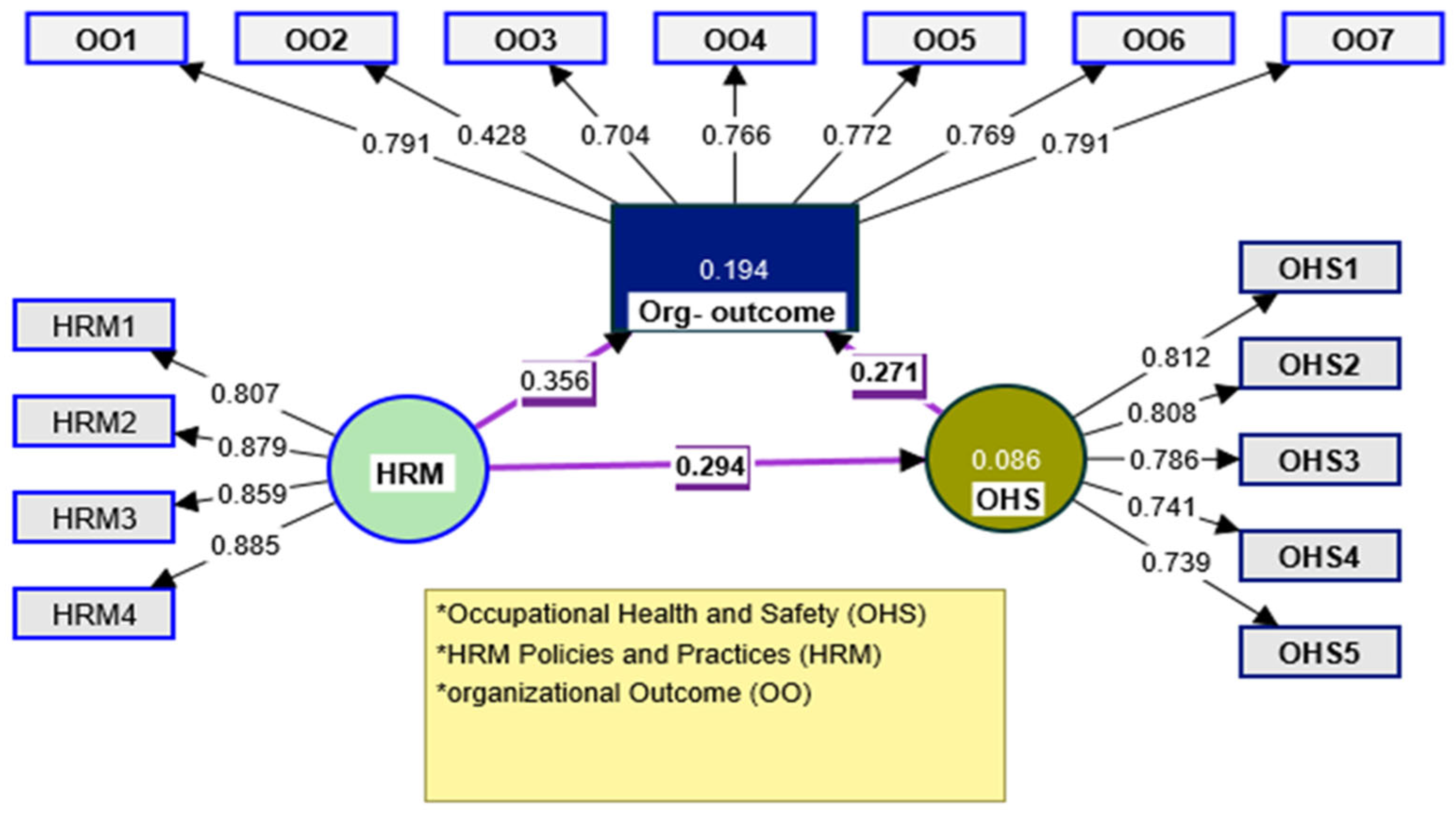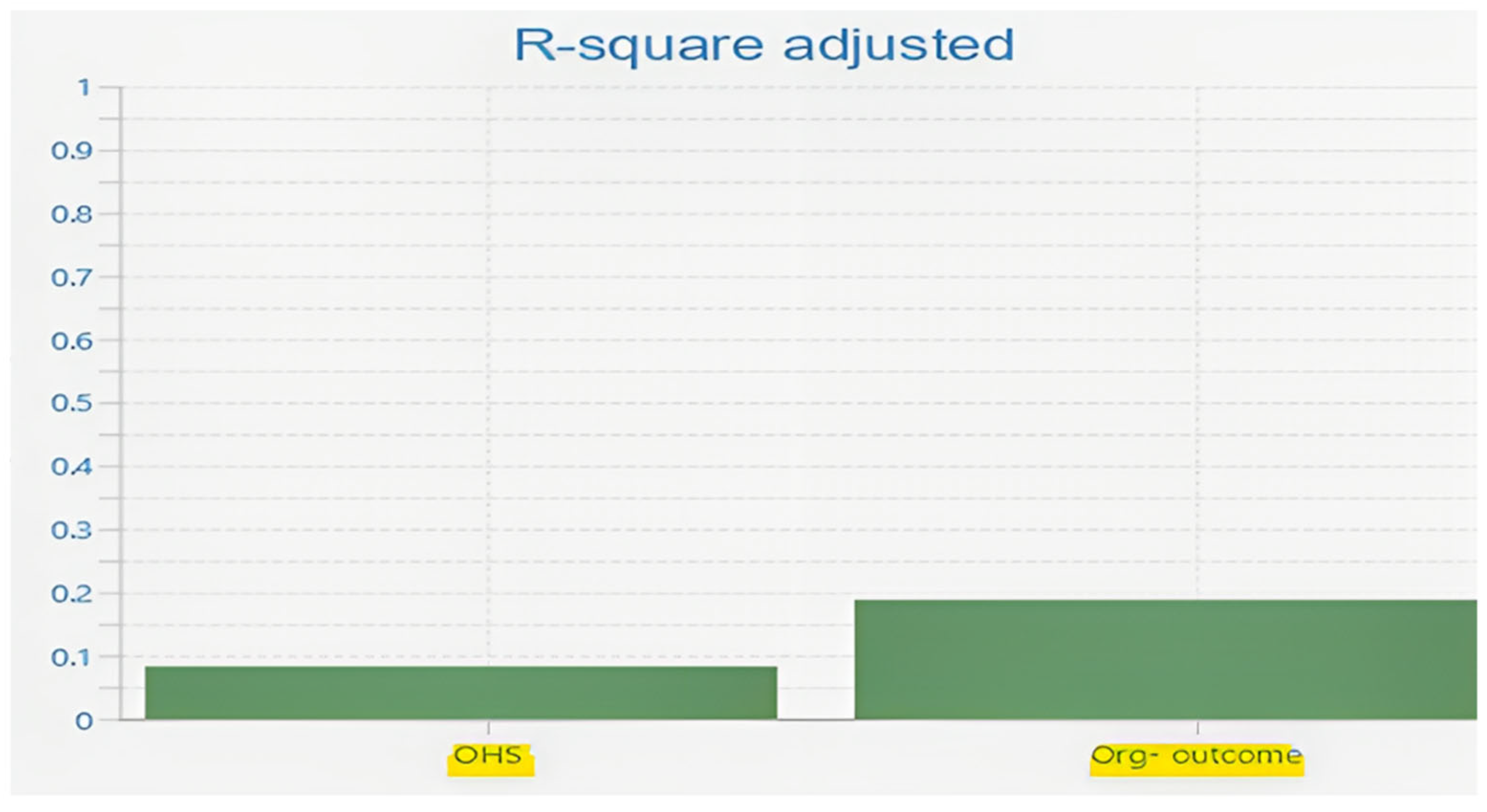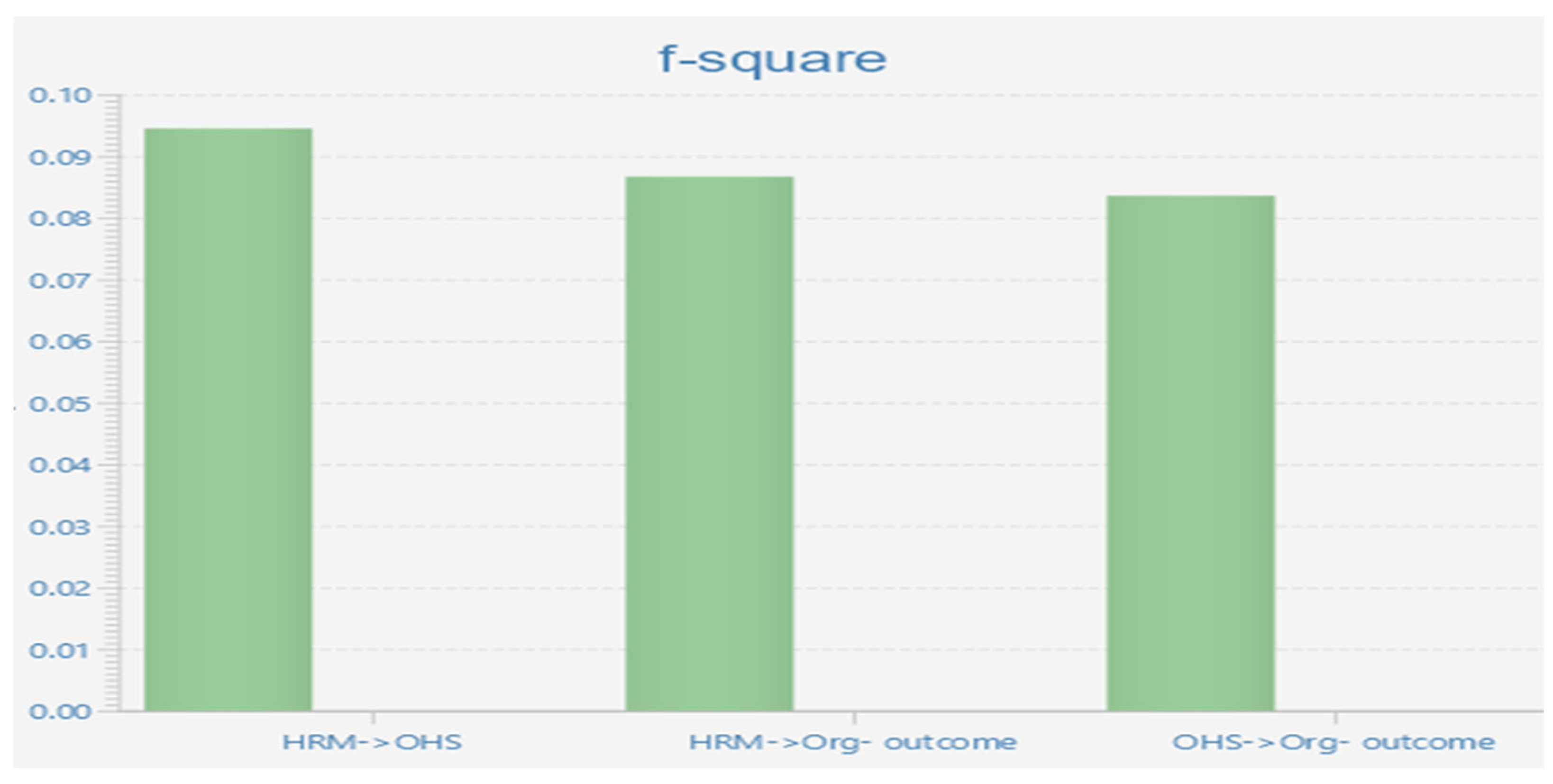Sustaining Organizational Outcomes in Manufacturing Firms: The Role of HRM and Occupational Health and Safety
Abstract
1. Introduction
2. Background of This Study
2.1. Challenge of Health and Safety Practices in the Manufacturing Industry
2.1.1. Risk Assessment and Management
2.1.2. Staff Training and Involvement
2.1.3. Communication
2.1.4. Mental Health and Well-Being
2.1.5. Technological Developments
3. Literature Review and Hypothesis Development
3.1. HRM Practices on Sustainable Organizational Outcomes (SOO)
3.2. The Relationship between Human Resource Management and Occupational Health and Safety
3.3. Occupational Health and Safety (OHS) and Organizational Outcomes
4. Methodology
4.1. Ethical Consideration
4.2. Sample
4.3. Survey
4.4. Data Analysis
5. Results
5.1. Background Characteristics of the Respondents
5.2. Reliability and Composite Reliability
5.3. Convergent Validity
5.4. Assessment of Measurement Model
5.5. Discriminant Validity for Latent Variables
5.6. The Prediction Relevance of the Model
5.7. Effect Size
5.8. The Assessment of the Inner Model and Hypotheses Testing Procedures
5.9. Path Model Significance Results
5.10. Testing the Level of Significance of the Indirect Effect
6. Discussion
6.1. Theoretical Implication
6.2. Practical Implication
7. Limitations and Future Research Directions
8. Conclusions
Author Contributions
Funding
Institutional Review Board Statement
Informed Consent Statement
Data Availability Statement
Conflicts of Interest
References
- Mazur, B.; Walczyna, A. Bridging sustainable human resource management and corporate sustainability. Sustainability 2020, 12, 8987. [Google Scholar] [CrossRef]
- Ghumiem, S.H.; Alawi, N.A.; Al-Refaei, A.A.-A.; Masaud, K.A. Corporate Culture and Its Effects on Organizational Performance: Multi-Group Analysis Evidence from Developing Countries. Eur. J. Bus. Manag. Res. 2023, 8, 142–148. [Google Scholar] [CrossRef]
- Buller, P.F.; McEvoy, G.M. Strategy, human resource management and performance: Sharpening line of sight. Hum. Resour. Manag. Rev. 2012, 22, 43–56. [Google Scholar] [CrossRef]
- Cherian, J.; Farouq, S. Does Effective Leadership Style Drive Financial Performance of Banks? Analysis in the Context of UAE Banking Sector. Int. J. Econ. Financ. 2013, 5, 105–114. [Google Scholar] [CrossRef]
- Al Marzooqi, A.H. The Study of Sustainable HRM and Its Impact on Employee Performance and Perceived Sustainable Organizational Support: The Mediating Role of Organizational Knowledge Sharing and Employee Empowerment. Doctoral Dissertation, Abu Dhabi University College of Business, Abu Dhabi, United Arab Emirates, 2019. [Google Scholar]
- Shedid, M. Employee Empowerment and Customer Satisfaction: An Investigation from a UAE Banking-Sector Perspective. Doctoral Dissertation, Robert Gordon University, Aberdeen, UK, 2019. [Google Scholar]
- Al-refaei, A.A.-A.; Zumrah, A.R.; Alsamawi, M.; Alshuhumi, S. A Multi-Group Analysis of the Effect of Organizational Commitment on Higher Education Services Quality. Int. J. Bus. Soc. 2019, 3, 40–48. [Google Scholar] [CrossRef]
- Baptiste, N.R. Tightening the link between employee wellbeing at work and performance: A new dimension for HRM. Manag. Decis. 2008, 46, 284–309. [Google Scholar] [CrossRef]
- Chiang, H.H.; Han, T.S.; Chuang, J.S. The relationship between high-commitment HRM and knowledge-sharing behavior and its mediators. Int. J. Manpow. 2011, 32, 604–622. [Google Scholar] [CrossRef]
- Abdulrahman, A.-M. Enhancement of Employees Performance via Professional Training and Development: A Study on Oil and Gas Companies Operating in Yemen. Int. J. Sci. Technol. Res. 2020, 9, 934–940. [Google Scholar]
- Hubbard, S.M.; Hubbard, B. A review of sustainability metrics for the construction and operation of airport and roadway infrastructure. Front. Eng. Manag. 2019, 6, 433–452. [Google Scholar] [CrossRef]
- Manuti, A.; Giancaspro, M.L. People make the difference: An explorative study on the relationship between organizational practices, employees’ resources, and organizational behavior enhancing the psychology of sustainability and sustainable development. Sustainability 2019, 11, 1499. [Google Scholar] [CrossRef]
- Avey, J.B.; Reichard, R.J.; Luthans, F.; Mhatre, K.H. Meta-analysis of the impact of positive psychological capital on employee attitudes, behaviors, and performance. Hum. Resour. Dev. Q. 2011, 22, 127–152. [Google Scholar] [CrossRef]
- Guest, D.E. Human resource management and employee well-being: Towards a new analytic framework. Hum. Resour. Manag. J. 2017, 27, 22–38. [Google Scholar] [CrossRef]
- Al-refaei, A.A.-Z.; Zumrah, A.R.; Alshuhumi, S.R. The Effect of Organizational Commitment on Higher Education Services Quality. E-J. Integr. Knowl. 2019, 7, 8–16. [Google Scholar] [CrossRef]
- Zumrah, A.R.B.; Bahaj, M.H.A.; Alrefai, A.S. An Empirical Investigation of the Effect of Training and Development on Organizational Commitment in Higher Education Sector. J. Int. Bus. Manag. 2021, 4, 1–15. [Google Scholar]
- Pfeffer, J. Building Sustainable Organizations: The Human Factor; Research Paper No. 2017; Research Paper Series; Stanford University Graduate School of Business: Stanford, CA, USA, 2009. [Google Scholar]
- Lakatos, J.; Drégelyi-Kiss, Á. Critical Comparison on Safety Management Systems, Identifying Opportunities for Companies Manufacturing and using Hazardous Substances. Interdiscip. Descr. Complex Syst. INDECS 2023, 21, 114–130. [Google Scholar] [CrossRef]
- Khalilzadeh, M.; Ghasemi, P.; Afrasiabi, A.; Shakeri, H. Hybrid fuzzy MCDM and FMEA integrating with linear programming approach for the health and safety executive risks: A case study. J. Model. Manag. 2021, 16, 1025–1053. [Google Scholar] [CrossRef]
- Albasteki, O.N.M.S. Corporate Stakeholders, Environmental and Social Risks, and Enterprise Risk Management: Towards an Integrating Framework. Doctoral Dissertation, Brunel University London, Uxbridge, UK, 2021. [Google Scholar]
- Lee, N.M. Health and Safety Risk Management-A cornerstone of Response Readiness. In Proceedings of the SPE International Conference and Exhibition on Health, Safety, Environment, and Sustainability, Perth, Australia, 11–13 September 2012; p. SPE–157130-MS. [Google Scholar]
- Richardson, B. Strategies for Promoting Inclusion and Employee Engagement to Improve Remote Teams’ Performance. Doctoral Dissertation, Walden University, Minneapolis, MN, USA, 2023. [Google Scholar]
- Saxe, K.; Beasley, L.; Abdulhussein, R. Team Environments Influence Student-Athlete Mental Health Through Mesolevel Interactions: An Ecological Systems Perspective. J. Issues Intercoll. Athl. 2022, 15, 558–584. [Google Scholar]
- Al Sayed, M. The Successful Management of a State-Owned Company—A Case Study of Gulf Petrochemical Industries Co. (GPIC); London School of Economics and Political Science (United Kingdom): London, UK, 2000. [Google Scholar]
- Jarrott, S.E.; Leedahl, S.N.; Shovali, T.E.; De Fries, C.; DelPo, A.; Estus, E.; Gangji, C.; Hasche, L.; Juris, J.; MacInnes, R. Intergenerational programming during the pandemic: Transformation during (constantly) changing times. J. Soc. Issues 2022, 78, 1038–1065. [Google Scholar] [CrossRef]
- Epstein, M.J.; Buhovac, A.R. A new day for sustainability. Strateg. Financ. 2014, 96, 25. [Google Scholar]
- Ghumiem, S.H.; Alawi, N.A.M. The Effects of Organizational Commitment on Non-Financial Performance: Insights from Public Sector Context in Developing Countries. J. Int. Bus. Manag. 2022, 5, 01–13. [Google Scholar]
- Stahl, G.; Brewster, C.; Collings, D.; Hajro, A. Enhancing the Role of HRM in Corporate Sustainability and Social Responsibility. Acad. Manag. Proc. 2019, 2019, 15402. [Google Scholar] [CrossRef]
- Schönborn, G.; Berlin, C.; Pinzone, M.; Hanisch, C.; Georgoulias, K.; Lanz, M. Why social sustainability counts: The impact of corporate social sustainability culture on financial success. Sustain. Prod. Consum. 2019, 17, 1–10. [Google Scholar] [CrossRef]
- Mousa, S.K.; Othman, M. The impact of green human resource management practices on sustainable performance in healthcare organisations: A conceptual framework. J. Clean. Prod. 2020, 243, 118595. [Google Scholar] [CrossRef]
- Acquah, I.S.K.; Agyabeng-Mensah, Y.; Afum, E. Examining the link among green human resource management practices, green supply chain management practices and performance. Benchmarking Int. J. 2020, 28, 267–290. [Google Scholar] [CrossRef]
- Ren, S.; Tang, G.; E Jackson, S. Green human resource management research in emergence: A review and future directions. Asia Pac. J. Manag. 2018, 35, 769–803. [Google Scholar] [CrossRef]
- Bakker, A.B.; Demerouti, E. Job demands–resources theory: Taking stock and looking forward. J. Occup. Health Psychol. 2017, 22, 273. [Google Scholar] [CrossRef]
- Adegbite, A.; Adeleke, O. International Labour Organization and Employment Stability during the COVID-19 Pandemic: The Nigerian Situational Analysis. 2023. Available online: https://ssrn.com/abstract=4347618 (accessed on 3 August 2023).
- Singh, S.; Mathur, D.; Adholiya, A.; Jain, S. Review of role of human resource management to ensure occupational health and safety system in construction industry. Mukt Shabd J. 2020, IX, 2256–2268. [Google Scholar]
- Naji, G.M.A.; Isha, A.S.N.; Alazzani, A.; Saleem, M.S.; Alzoraiki, M. Assessing the mediating role of safety communication between safety culture and employees safety performance. Front. Public Health 2022, 10, 840281. [Google Scholar] [CrossRef] [PubMed]
- EU-OSHA Report Highlights Technology to Help Identify Health Problems. Available online: https://www.proquest.com/openview/3d4c405652ed29460c925a760844e4e7/1?pq-origsite=gscholar&cbl=47267 (accessed on 3 August 2023).
- Mannella, J. Health and Safety Legislation in Canada, Canadian Centre for Occupational Health and Safety (CCOHS). 2023. Available online: https://www.ccohs.ca/oshanswers/legisl/legislation/posting.html (accessed on 13 September 2023).
- Makori, E.M.; Thuo, J.; Wanyama, K.W. Influence of Occupational Health and Safety Programmers on Performance of Manufacturing Firms in Western Province, Kenya. 2012. Available online: http://erepository.kibu.ac.ke/handle/123456789/1014 (accessed on 3 August 2023).
- Pike, A. Tough Targets and Heavy Penalties: Financial Times: Business Health and Safety; London Printers: London, UK, 2000. [Google Scholar]
- Alsamawi, M.A.; Darun, M.R.; Panigrahi, S.K. Investigating the Effect of Corporate Social Responsibility and Affective Commitment on Corporate Performance in Oil and Gas Corporations in Yemen. J. Adv. Res. Bus. Manag. Stud. 2019, 17, 41–56. [Google Scholar]
- Alsamawi, M.; Mohd, D.; Shrikant, P.; Al-Refaei, A.A.-A. The Effect of Corporate Social Responsibility on Corporate Performance in Oil and Gas Industry. J. Adv. Res. Soc. Behav. Sci. 2019, 16, 1–14. [Google Scholar] [CrossRef]
- Bell, S.L.; Phoenix, C.; Lovell, R.; Wheeler, B.W. Seeking everyday wellbeing: The coast as a therapeutic landscape. Soc. Sci. Med. 2015, 142, 56–67. [Google Scholar] [CrossRef] [PubMed]
- Yanar, B.; Robson, L.S.; Tonima, S.K.; Amick III, B.C. Understanding the organizational performance metric, an occupational health and safety management tool, through workplace case studies. Int. J. Workplace Health Manag. 2020, 13, 117–138. [Google Scholar] [CrossRef]
- Gopang, M.A.; Nebhwani, M.; Khatri, A.; Marri, H.B. An assessment of occupational health and safety measures and performance of SMEs: An empirical investigation. Saf. Sci. 2017, 93, 127–133. [Google Scholar] [CrossRef]
- Kaaria, A.G.; Mwaruta, S.S. Mental Health Ingenuities and the Role of Computer Technology on Employees’ Mental Health: A Systematic Review. East Afr. J. Health Sci. 2023, 6, 219–231. [Google Scholar] [CrossRef]
- Ateeq, A.; Ebrahim, S.; Al-Ghatam, R. The impact of stress and its influencing factors among dentists during the COVID-19 pandemic in Kingdom of Bahrain. F1000Research 2022, 11, 930. [Google Scholar] [CrossRef]
- Habtoor, N.H.; Ali, E.S. Human side of total quality management: A critical review. Int. J. Intellect. Hum. Resour. Manag. (IJIHRM) 2022, 3, 27–32. [Google Scholar] [CrossRef]
- Ali, A.A.A.; Alzoraiki, M.; Al Aghbas, N.S.M. Working remotely, social isolation and access to support and communication during COVID-19 its influence on job performance. Int. J. Intellect. Hum. Resour. Manag. 2022, 3, 23–33. [Google Scholar]
- Ali, A.A.A. The Relationship between Islamic Work Ethics and Employee Performance among Medical Staff in the Public Health Sector in Bahrain: Employee Commitment as Mediating Variable. Ph.D. Thesis, Universiti Sains Islam Malaysia, Nilai, Malaysia, 2022. [Google Scholar]
- Ali, A.A.A.; Alzoraiki, M.; Al-shaibah, M.; Almaamari, Q. Enhancing contextual performance through Islamic work ethics with mediating role of normative commitment. Math. Stat. Eng. Appl. 2022, 71, 8668–8683. [Google Scholar] [CrossRef]
- Naz, S.; Li, C.; Nisar, Q.A.; Khan, M.A.S.; Ahmad, N.; Anwar, F. A study in the relationship between supportive work environment and employee retention: Role of organizational commitment and person–organization fit as mediators. Sage Open 2020, 10, 2158244020924694. [Google Scholar] [CrossRef]
- Al-Muhrami, M.A.S.; Alawi, N.A.; Alzubi, M.; Al-Refaei, A.A.-A. Affecting the behavioural intention to use electronic banking services among users in Yemen: Using an Extension of the unified theory of acceptance and use of technology. In Proceedings of the 2021 2nd International Conference on Smart Computing and Electronic Enterprise (ICSCEE), Kuala Lumpur, Malaysia, 15–17 June 2021; pp. 257–264. [Google Scholar]
- Al Balushi, F.S.M.; Ali, A.A.A.; Alzoraiki, M. The Impact of Forecasting Strategy and Training and Development Strategy on Preparing Leadership Competencies Administrative Support in the Sultanate of Oman. Int. J. Intellect. Hum. Resour. Manag. 2022, 3, 34–41. [Google Scholar]
- Al-refaei, A.A.-A.; Ali, H.B.M.; Ateeq, A.A.; Alzoraiki, M. An Integrated Mediating and Moderating Model to Improve Service Quality through Job Involvement, Job Satisfaction, and Organizational Commitment. Sustainability 2023, 15, 7978. [Google Scholar] [CrossRef]
- Naji, G.M.A.; Isha, A.S.N.; Alzoraiki, M.; Sharafaddin, O.; Ghaleb, E.A.; Ammar, A.-A. Executive Compensation-Ethical Issues in Human Resource. Int. J. Intellect. Hum. Resour. Manag. 2022, 3, 17–22. [Google Scholar]
- Ali, A.A.A.; Alzoraiki, M.; AL-Tahitah, A.N.; Almaamari, Q.; Al-shaibah, M. Association between Islamic Work Ethics and Employee Commitment Among Medical Staff in the Public Health Sector in Bahrain. Int. J. Intellect. Hum. Resour. Manag. 2023, 4, 1–11. [Google Scholar]
- Afthanorhan, A.; Ghazali, P.L.; Rashid, N. Discriminant validity: A comparison of CBSEM and consistent PLS using Fornell & Larcker and HTMT approaches. J. Phys. Conf. Ser. 2021, 1874, 012085. [Google Scholar]
- Shiau, W.-L.; Sarstedt, M.; Hair, J.F. Internet research using partial least squares structural equation modeling (PLS-SEM). Internet Res. 2019, 29, 398–406. [Google Scholar] [CrossRef]
- Donthu, N.; Kumar, S.; Pattnaik, D.; Campagna, C. Journal of marketing theory and practice: A retrospective of 2005–2019. J. Mark. Theory Pract. 2020, 28, 117–137. [Google Scholar] [CrossRef]
- Rahmat, S.; Altowayti, W.A.H.; Othman, N.; Asharuddin, S.M.; Saeed, F.; Basurra, S.; Eisa, T.A.E.; Shahir, S. Prediction of Wastewater Treatment Plant Performance Using Multivariate Statistical Analysis: A Case Study of a Regional Sewage Treatment Plant in Melaka, Malaysia. Water 2022, 14, 3297. [Google Scholar] [CrossRef]
- Ali, A.A.A.; Habtoor, N. Islamic Work Ethics and its Impact on Enhancing Organizational Commitment in Bahraini Private Educational Universities. Int. J. Intellect. Hum. Resour. Manag. 2022, 3, 33–42. [Google Scholar] [CrossRef]
- Ali, A.A.A.; AlZgool, M.; Alzoraiki, M.; Milhem, M.; Al-Absy, M.S.M. Moderating Effect of Strategic Planning on the Relationship between Career Path Planning and Job Performance. Sustainability 2023, 15, 8490. [Google Scholar] [CrossRef]
- Cheah, C.S. Factors contributing to the difficulties in teaching and learning of computer programming: A literature review. Contemp. Educ. Technol. 2020, 12, ep272. [Google Scholar] [CrossRef]
- Juraska, J. Diversifying Language Generated by Deep Learning Models in Dialogue Systems; University of California, Santa Cruz: Santa Cruz, CA, USA, 2022. [Google Scholar]
- Eling, M.; McShane, M.; Nguyen, T. Cyber risk management: History and future research directions. Risk Manag. Insur. Rev. 2021, 24, 93–125. [Google Scholar] [CrossRef]






| Characteristics | Categories | n | Percentage (%) |
|---|---|---|---|
| Gender | Male | 143 | 92.8 |
| Female | 11 | 7.2 | |
| Age | Less than 30 | 42 | 27.2 |
| 31–40 | 69 | 44.8 | |
| 41–50 | 26 | 16.8 | |
| above 50 | 17 | 11 | |
| Experience | <10 | 22 | 14.2 |
| >10 | 132 | 85.7 | |
| Education | High school | 82 | 53.2 |
| Diploma | 37 | 24 | |
| Bachelor | 18 | 11.5 | |
| Others | 17 | 11 |
| Constructs | Number of Items | Code | Mean ± SD | Rank |
|---|---|---|---|---|
| HRM Policies and Practices | 4 | HRM | 0.858 ± 0.016 | 1 |
| Occupational Health and Safety (OHS) | 5 | OHS | 0.776 ± 0.024 | 2 |
| Sustainable Organizational Outcome | 7 | OO | 0.714 ± 0.035 | 3 |
| Average | 16 | 0.783 ± 0.025 |
| Construct | Cronbach’s Alpha | Composite Reliability | Average Variance Extracted |
|---|---|---|---|
| HRM | 0.881 | 0.890 | 0.737 |
| OHS | 0.837 | 0.844 | 0.605 |
| Org- outcome | 0.845 | 0.840 | 0.529 |
| Construct | Code | Number of Items | Factor | Construct | Code |
|---|---|---|---|---|---|
| HRM | HRM | 4 | 0.858 | 0.890 | 0.737 |
| OHS | OHS | 5 | 0.777 | OHS | OHS |
| Sustainable Org- outcome | OO | 7 | 0.717 | 0.840 | 0.529 |
| HRM | OHS | Org- Outcome | |
|---|---|---|---|
| HRM | 0.858 | ||
| OHS | 0.294 | 0.778 | |
| Org- outcome | 0.356 | 0.353 | 0.727 |
| R-Square | R-Square Adjusted | |
|---|---|---|
| OHS | 0.086 | 0.083 |
| Org- outcome | 0.194 | 0.188 |
| f-Square | |
|---|---|
| HRM → OHS | 0.094 |
| HRM → Org- outcome | 0.087 |
| OHS → Org- outcome | 0.084 |
| NO | Hypothesis | β | μ | SD | T. Value | p Values | Decision |
|---|---|---|---|---|---|---|---|
| H1 | HRM → OHS | 0.294 | 0.299 | 0.060 | 4.889 | 0.000 | Supported |
| H2 | HRM → Org- outcome | 0.276 | 0.279 | 0.058 | 4.728 | 0.000 | Supported |
| H3 | OHS → Org- outcome | 0.271 | 0.277 | 0.059 | 4.623 | 0.000 | Supported |
| Original Sample (O) | Sample Mean (μ) | Standard Deviation (STDEV) | T Statistics (|O/STDEV|) | p Values | |
|---|---|---|---|---|---|
| HRM → OHS → Org- outcome | 0.08 | 0.083 | 0.026 | 3.082 | 0.002 |
Disclaimer/Publisher’s Note: The statements, opinions and data contained in all publications are solely those of the individual author(s) and contributor(s) and not of MDPI and/or the editor(s). MDPI and/or the editor(s) disclaim responsibility for any injury to people or property resulting from any ideas, methods, instructions or products referred to in the content. |
© 2024 by the authors. Licensee MDPI, Basel, Switzerland. This article is an open access article distributed under the terms and conditions of the Creative Commons Attribution (CC BY) license (https://creativecommons.org/licenses/by/4.0/).
Share and Cite
Ateeq, A.; Al-refaei, A.A.-A.; Alzoraiki, M.; Milhem, M.; Al-Tahitah, A.N.; Ibrahim, A. Sustaining Organizational Outcomes in Manufacturing Firms: The Role of HRM and Occupational Health and Safety. Sustainability 2024, 16, 1035. https://doi.org/10.3390/su16031035
Ateeq A, Al-refaei AA-A, Alzoraiki M, Milhem M, Al-Tahitah AN, Ibrahim A. Sustaining Organizational Outcomes in Manufacturing Firms: The Role of HRM and Occupational Health and Safety. Sustainability. 2024; 16(3):1035. https://doi.org/10.3390/su16031035
Chicago/Turabian StyleAteeq, Ali, Abd Al-Aziz Al-refaei, Mohammed Alzoraiki, Marwan Milhem, Ali Nasser Al-Tahitah, and Abdulhadi Ibrahim. 2024. "Sustaining Organizational Outcomes in Manufacturing Firms: The Role of HRM and Occupational Health and Safety" Sustainability 16, no. 3: 1035. https://doi.org/10.3390/su16031035
APA StyleAteeq, A., Al-refaei, A. A.-A., Alzoraiki, M., Milhem, M., Al-Tahitah, A. N., & Ibrahim, A. (2024). Sustaining Organizational Outcomes in Manufacturing Firms: The Role of HRM and Occupational Health and Safety. Sustainability, 16(3), 1035. https://doi.org/10.3390/su16031035






